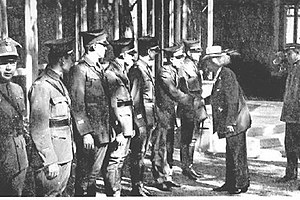Kościuszko's Squadron
| Kościuszko Squadron | |
|---|---|
 American aviators in Paris meet Ignacy Jan Paderewski, prime minister of Poland, in 1919[1] | |
| Active | December 1919 |
| Allegiance | |
| Branch | |
| Type | Fighter squadron |
| Patron | Tadeusz Kościuszko |
| Engagements | |
| Insignia | |
| Roundel | |
| Aircraft flown | |
| Fighter | Albatros D.III (Oeffag), Ansaldo A.1 Balilla |
The Kościuszko Squadron (officially: Polish 7th Air Escadrille) was a Polish Air Force fighter squadron established in late 1919 by Merian C. Cooper, an American aviator who would go on to direct the film King Kong in 1933. The unit was named after Tadeusz Kościuszko, and Major Cedric Fauntleroy became its commander. The squadron's insignia was designed by Elliot William Chess (1899–1962), an American pilot serving with the Polish Army during the Polish–Soviet War. To encourage the recruitment of Americans of Polish descent, the Polish military set up a unit called the Polish–American Air Group.
The most famous successor to this original Kościuszko Squadron was the World War II No. 303 "Kościuszko" Polish Fighter Squadron (Warszawski im. Tadeusza Kościuszki), the most successful fighter squadron in the Battle of Britain.
Formation
First formed after Poland regained independence following World War I, it consisted of a small group of American volunteers independent of the United States State Department or the American Expeditionary Forces.[2] The fliers came from a number of militaries. Members included Ludomił Rayski (commander and of the Turkish Air Force), Jerzy Weber (of the Imperial Russian Air Service), Władysław Konopka , Aleksander Seńkowski (of the Austrian Air Service), and Ludwik Idzikowski (of the Imperial Russian Air Service).[3]
One of the most famous pilots was Merian C. Cooper, producer of the 1933 movie King Kong, who was decorated for valor by Polish commander-in-chief Józef Piłsudski with the highest Polish military decoration, the Virtuti Militari. During World War II the Kościuszko Squadron was formed by refugee Polish pilots who joined the Royal Air Force and played an essential role during the Battle of Britain.[4]
The Kościuszko Squadron emblem depicts the distinctive four-cornered rogatywka (red cap of traditional Polish style) set against a field of seven red vertical stripes on a white background (forming six white stripes as a result) from the flag of the United States, red and white also being two colors contained in both the Polish and American flags. Behind the red cap is a pair of crossed scythes. Thirteen blue stars encircle the badge, representing the thirteen original American states.[5] The rogatywka cap and scythes commemorate the Kościuszko Uprising of 1794: ten years after General Tadeusz Kościuszko returned to Poland from America, and led the Polish people, many armed only with scythes, in an attempt to liberate Poland from Russia and Prussia.
See also
- Blue Army – Polish Army unit partly made up of North Americans of Polish ancestry
- Lafayette Escadrille – French squadron of American pilots
References
Footnotes
- ^ The Logan Republican, November 29, 1919, p. 1.
- ^ Cisek 2002, p. 1.
- ^ Cisek 2002.
- ^ Olson & Cloud 2004, p. 124.
- ^ Fiedler 2010.
Bibliography
- Cisek, Janusz (2002). Kosciuszko, We Are Here!: American Pilots of the Kosciuszko Squadron in Defense of Poland, 1919-1921. McFarland. ISBN 9780786412402.
- Fiedler, Arkady (2010). 303 Squadron: The Legendary Battle of Britain Fighter Squadron. Aquila Polonica. ISBN 9781607720041.
- "American Aviators in Poland". The Logan Republican. Logan, Cache, Utah: N.R. Moore. 2019. pp. 1–7. ISSN 2158-2815. OCLC 12654497. Retrieved November 29, 2019.
- Olson, Lynne; Cloud, Stanley (2004). A Question of Honor: The Kosciuszko Squadron: Forgotten Heroes of World War II. Vintage Books. ISBN 9780375726255.
External links
 Media related to Kościuszko's Squadron at Wikimedia Commons
Media related to Kościuszko's Squadron at Wikimedia Commons
